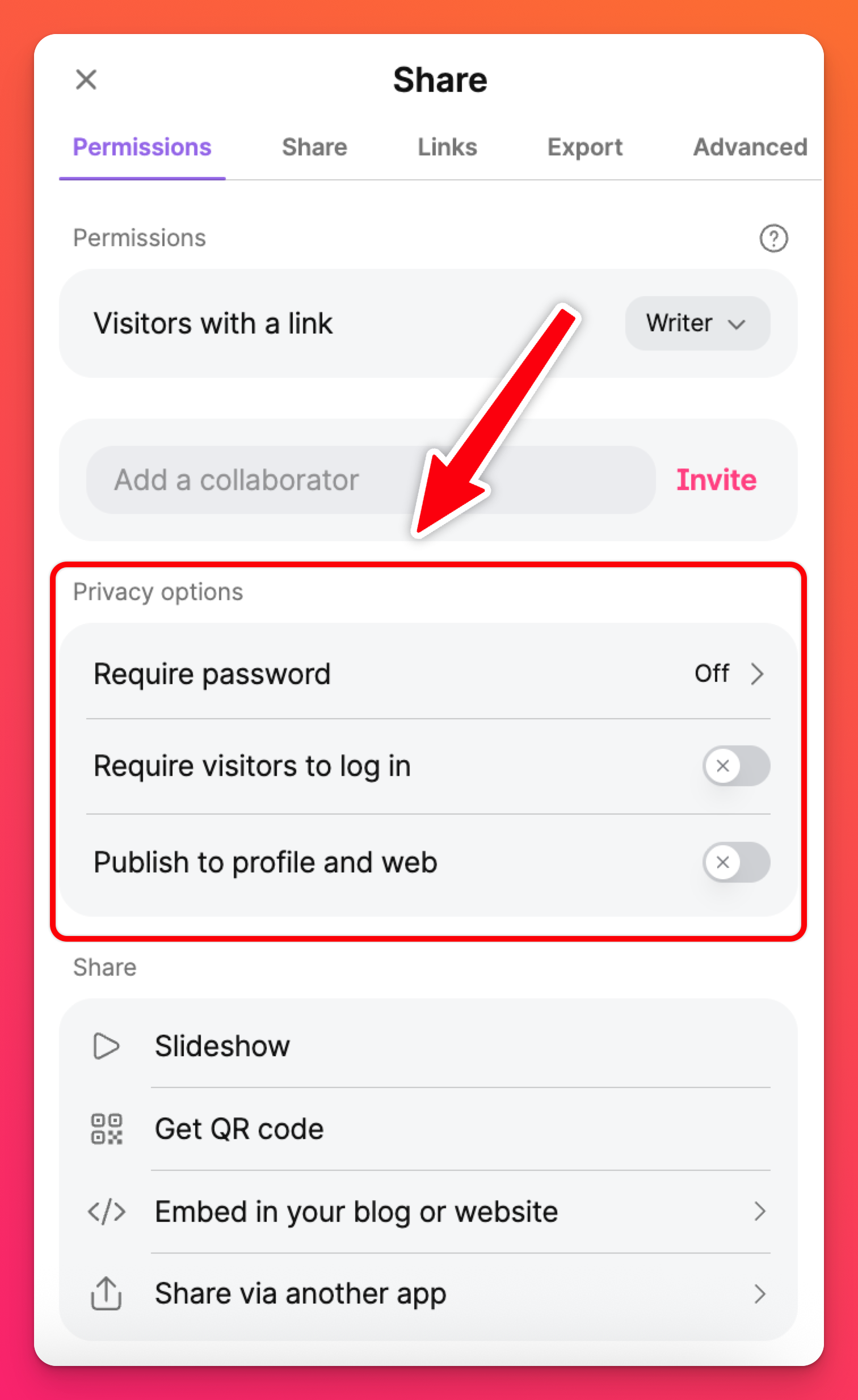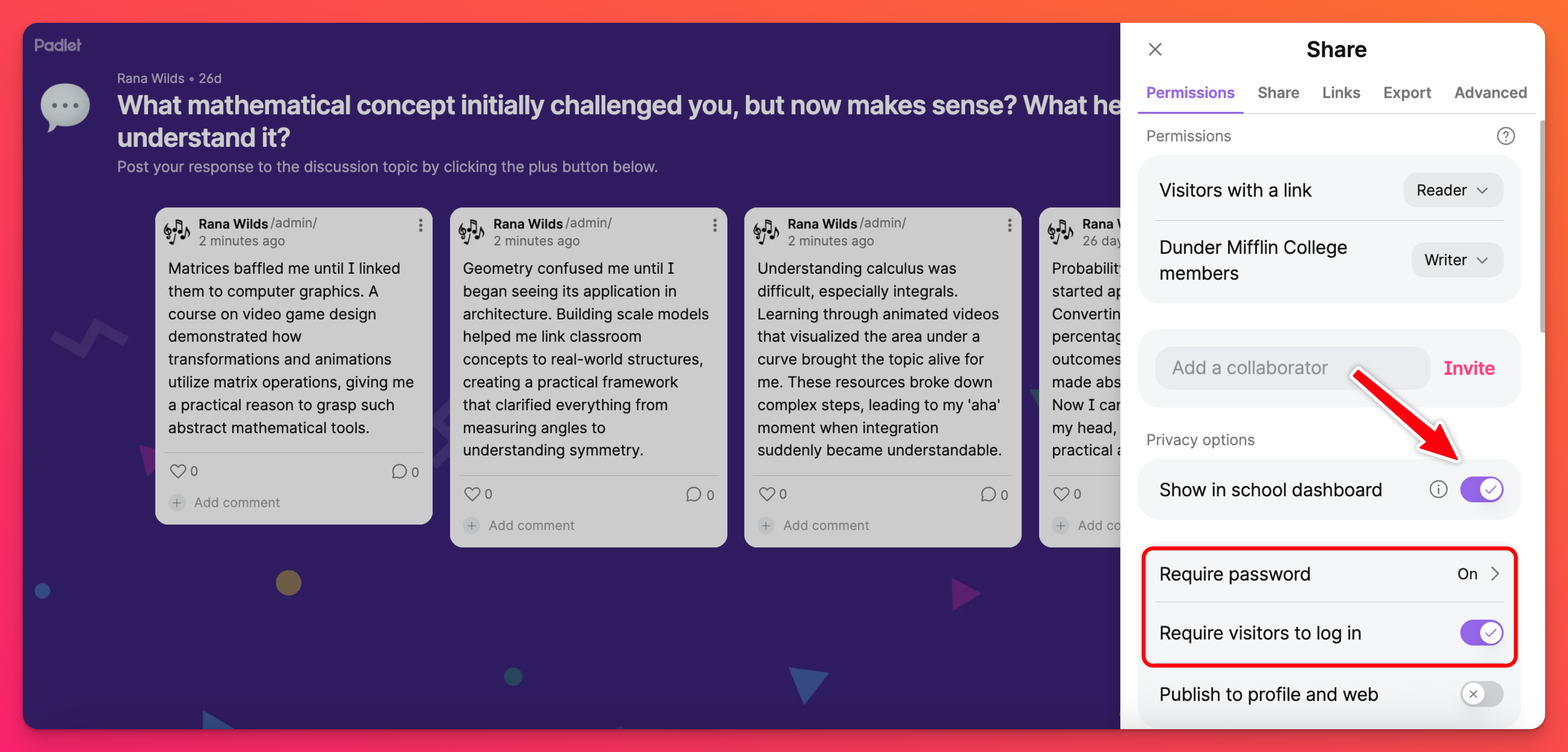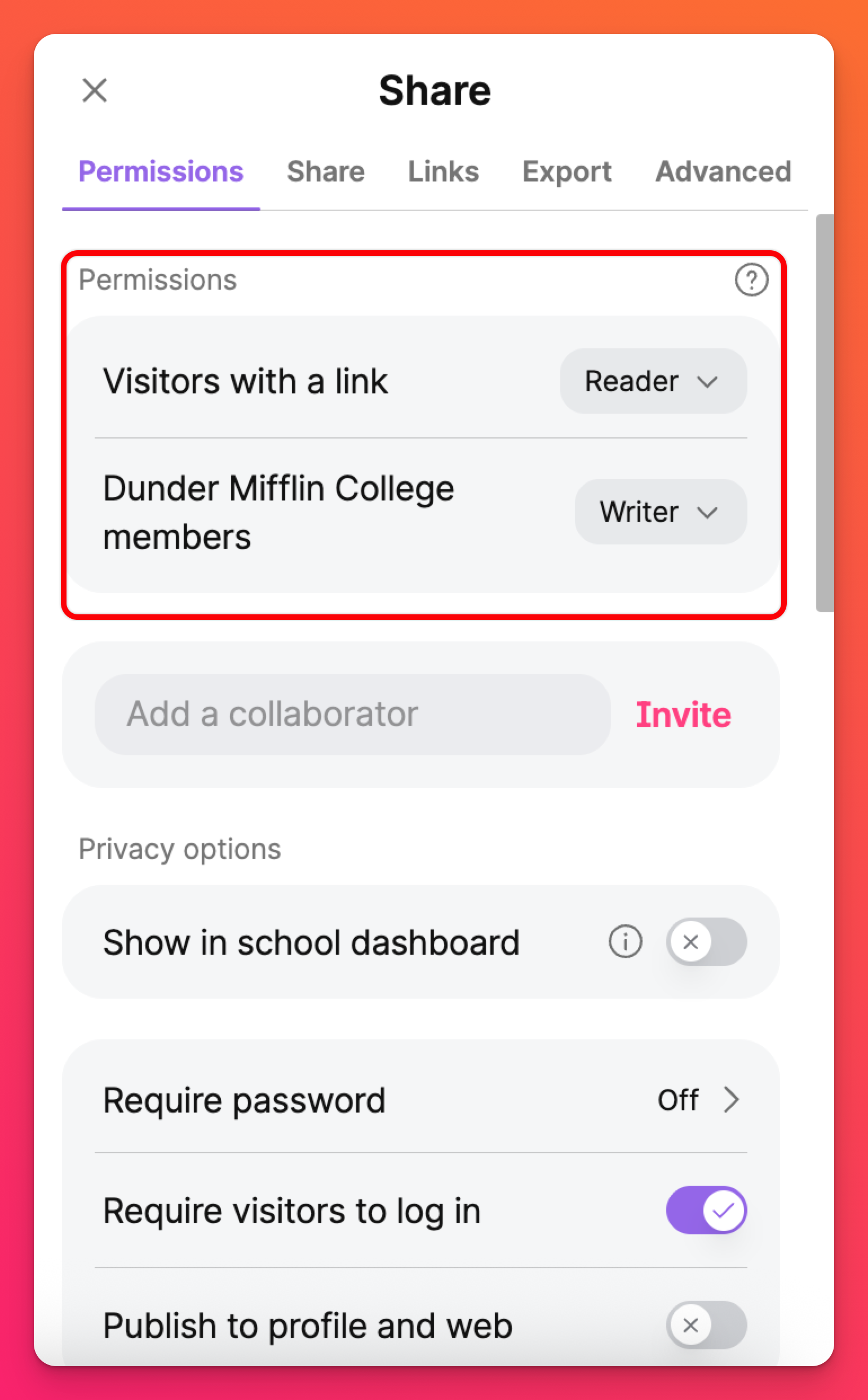Privacy and permission settings
Privacy and permissions are vital to protecting your padlet's content. Learn more about the privacy and permissions options and which will work best for you!
Accessing privacy settings
When creating a padlet, choose a privacy setting to control who has access to the padlet.
Access the privacy settings by clicking the Share arrow in the upper-right corner of any padlet. Then, under the 'Privacy options' section, choose the privacy level for the padlet.

Privacy options
Choose between the following privacy options for your desired level of security.
Privacy option | Description | How to use this option |
Require password | Users will need the link to the padlet and the special password to access the content. | In the Share panel, click on Require password under the 'Privacy options' section >> toggle the button ON >> type in the desired password >> click Save. |
Require visitors to log in | Require that users are logged into a Padlet account before they can access the content. This setting prevents anonymous posts from being added to the padlet. Comments and posts will display the author's name when this feature is enabled. | In the Share panel, click on Require visitors to log in under the 'Privacy options' section >> toggle the button ON. |
Publish to profile and web | This option publishes the padlet for all to see! *Users can stumble upon the padlet in search engines, by navigating to your Padlet profile, with the link, etc. To keep the padlet from being publicly viewable, we recommend keeping this toggle OFF or adding a second privacy option. | In the Share panel, click on Publish to profile and web under the 'Privacy options' section >> toggle the button ON. |
Show in Team/Classroom/School dashboard *Only available in Team Gold, Classroom and School accounts | When this option is toggled ON, the padlet will become visible to your organization within the All padlets tab. | In the Share panel, click on Show in team/classroom/school dashboard under the 'Privacy options' section >> toggle the button ON. |
* = Make the padlet visible from your profile page but not listed in search engines by choosing Publish to profile and web AND Require password.
Selecting multiple privacy options
Choose more than one privacy option for added protection! Below are some examples you can choose from.

- Require password AND Require visitors to log in -- Users will have to log into their account first and then enter the preset password for the padlet.
- Show in Team/Classroom/School dashboard AND Require password -- The padlet thumbnail will be viewable from the creator's profile page and within the Team/Classroom/School's shared dashboard. Once the padlet is selected, users will need to enter the preset password to view the content.
- Publish to profile and web AND Require password -- The padlet thumbnail will be viewable from the creator's profile page but will not be indexed for web searching. Once the padlet is selected, users will need to enter the preset password to view the content.
- Publish to profile and web AND Require visitors to log in -- The padlet thumbnail will be viewable from the creator's profile page and it will also be indexed for web searching. Once the padlet is selected, users will need to log into their Padlet account to view the content.
Accessing visitor permissions
Assign each user that visits your padlet specific permissions. This determines what each user can actually do on the padlet once they get there.
Access the permissions by clicking the Share arrow in the upper-right corner of any padlet. Then, under the 'Permissions' section, choose the options you'd like to allow.

Permissions options
Choose between the following permission options to determine the level of editing access to allow for visitors to the padlet.
Permission option | Description |
No access | Only the padlet creator and users added as collaborators can access the board. To read more about adding users as collaborators, click here. |
Reader | Visitors can access the padlet and read existing posts. |
Commenter | Visitors can comment on existing posts and add reactions/votes. |
Writer | Visitors can access the padlet, create new posts, read existing posts and comment/react. |
Moderator | Visitors can read, write, comment, edit and approve posts. |
Admin | Users can create, edit, and approve posts. They can also invite collaborators and modify the padlet. Admins have the same editing permissions as the Owner/Creator of the padlet - including access to delete the padlet. |
FAQs
Why can't users post on my padlet?
I want to prevent others from adding posts on my padlet (except for a select few). How can I set this up?
This ensures the specific users can create posts on the padlet, while everyone else can only read or comment.
I have my padlet's privacy option set to Require password. Some users can bypass the password. Why? Is my padlet still protected?
*Collaborators you've invited via the 'Add a collaborator' field
*Owner of the individual padlet
*Owners of a Team/Classroom/School
*Admins in a Team/Classroom/School
*Teachers in a Classroom/School
Makers and Contributors (in a Team) and Students (in a Classroom or School) will still need to enter the password to have access to the padlet.
Can I choose more than one privacy option at a time?
*Require password AND Require visitors to log in -- Users will have to log into their account first and then enter the preset password for the padlet.
*Show in Team/Classroom/School dashboard AND Require password -- The padlet thumbnail will be viewable from the creator's profile page and within the Team/Classroom/School's shared dashboard. Once the padlet is selected, users will need to enter the preset password to view the content.
*Publish to profile and web AND Require password -- The padlet thumbnail will be viewable from the creator's profile page but will not be indexed for web searching. Once the padlet is selected, users will need to enter the preset password to view the content.
*Publish to profile and web AND Require visitors to log in -- The padlet thumbnail will be viewable from the creator's profile page and it will also be indexed for web searching. Once the padlet is selected, users will need to log into their Padlet account to view the content.

